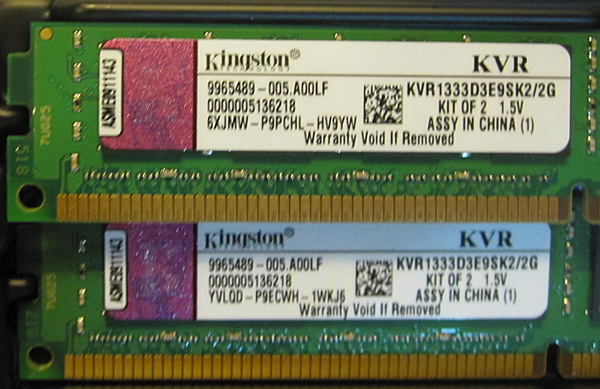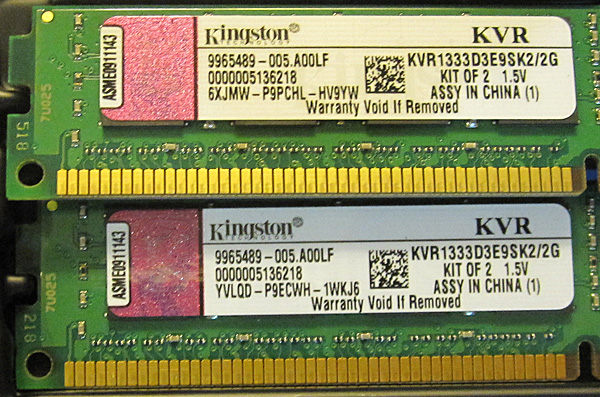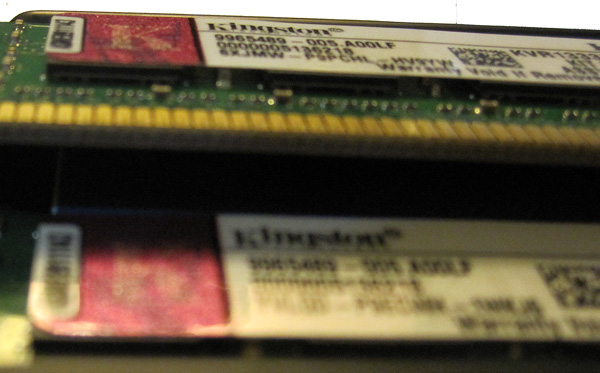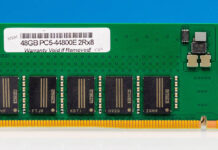Recently I have been testing several AMD G34 and Intel 5520 series platforms. Each AMD G34 CPU requires four sticks of memory for full quad channel operation, and each Intel CPU requires at least three DIMMs for triple channel operation. With fourteen G34 sockets and dodeca core Magny cours CPUs in various stages of testing, the G34 platforms alone require a minimum of 56 DIMMs. Needless to say, recently I have found myself scrambling to find sets of matching DIMMs and purchased Amazon.com’s entire inventory of 2x 1GB ECC 1333 DIMM kits one week (over a dozen pairs.) This led me to alternative sources, which turned out to be perilous.
About three weeks ago I found a Craigslist listing for many kits of Kingston ValueRAM 2GB ECC UDIMMs for sale at slightly lower prices than online retail. Upon inspection, I noticed something fishy that one really needs to be vigilant in looking for, the security label on Kingston DRAM modules. The net effect was that during the meet-up I determined that the DIMMs were counterfeit and was able to avoid the transaction (the seller literally running away.)
Kingston security labels incorporate color-shifting ink technology, similar to what is used by the US dollar ($10 denominations and above) and many other currencies as well as consumer products like the old Ford Mustang Mystichrome paint. This technology is the SecureShift ink from JDSU, the same company that makes fiber optic transceivers for data communication. I am not familiar enough with the product to know if it is standard secure shift or MetaSwitch technology, but one can read about the JDSU Authentication Solutions here.
The older Kingston DRAM modules used SecureShift ink on glossy security labels that would change colors as the label was viewed at different angles. Newer DIMMs use a more advanced protection scheme which we will look at. First looking at the Kingston security label one can see the face of Kingston branding on an otherwise solid label:

SecureShift changes color based upon viewing angle so from some angles the security label can look almost solid in color.

Looking at yet another angle, the new Kingston security label has a “K” clearly visible.

Ensuring that one sees these patters is essential to verify that the product being purchased is genuine. I have not tried this, but generally security labels have very sensitive adhesive that separates if the label is removed after being affixed, even under intense heat or cold. If one does purchase counterfeit memory, one is likely to have no warranty and worse, they can be purchasing under performing memory or DIMMs that are not error free. The DIMMs someone attempted to sell me did not shift colors or patterns when angling the labels, they were a flat purple-pink color.
Conclusion
Kingston now ships single DIMMs and kits with clear packaging and the security labels visible. Take care to always check the labels. Another best practice is purchasing only from authorized distribution channels to ensure that the product is legitimate. Without being familiar with the security labels I probably would have purchased the counterfeit memory so I thought others may be interested in the technology behind this, and the practice of checking the security labels. Kingston has an anti-counterfeiting page, but for some reason I could not find this information on their website.




wow nice catch PJK.
Thank you very much. Do you mean that on a simple picture you could notice that label stick wasn’t right ?
I would’ve reported that clown to Kingston